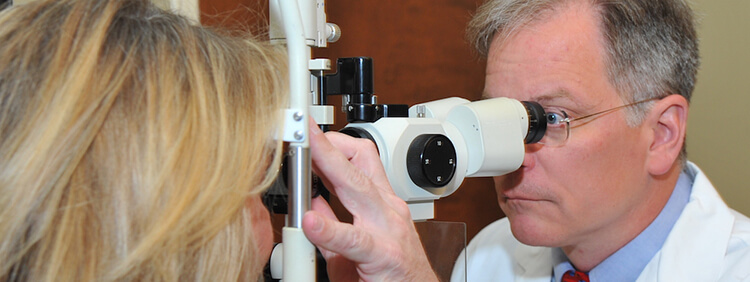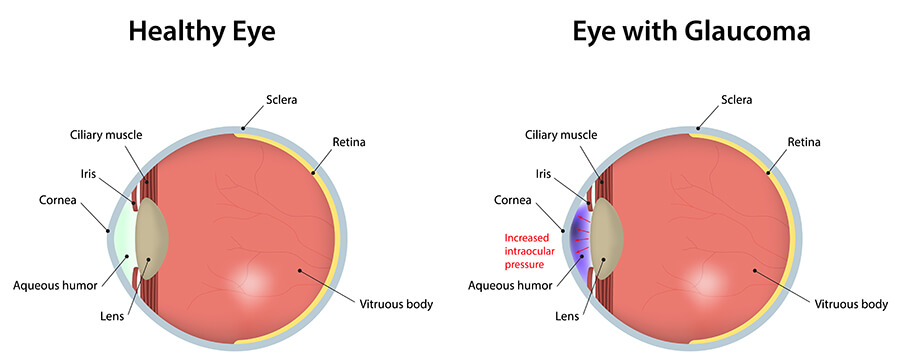
Glaucoma Damages the Optic Nerve
Glaucoma is a leading cause of blindness in the United States. Early treatment can often prevent loss of sight. Glaucoma affects the optic nerve. The optic nerve is made up of nerve fibers that carry images to the brain. It’s like an electric cable containing numerous wires. When glaucoma damages the optic nerve fibers, blind spots develop. If the entire nerve is destroyed, blindness results. Glaucoma is often related to an increase in intraocular pressure (IOP), although this is not always true.

There are Several Types of Glaucoma
Primary Open-Angle Glaucoma is the most common form of glaucoma in the United States. Typically, open-angle glaucoma has no symptoms in its early stages, and vision remains normal. The pressure of the eye slowly rises and after time with this elevated pressure, nerve damages occur. As the optic nerve becomes more damaged, blank spots begin to appear in your field of vision. You typically won’t notice these blank spots in your day-to-day activities until the optic nerve is significantly damaged and these spots become large. If all the optic nerve fibers die, blindness results. This is why it is important to have annual eye exams to detect and treat the eye before damage occurs.
In Angle-Closure Glaucoma the aqueous fluid is blocked from flowing back out of the eye at a normal rate through its natural drainage system. This may occur if the iris (the colored part of the eye) moves and causes the drainage angle in the eye to become closed off, leading to a sudden increase in eye pressure and potential optic nerve damage. This condition is considered an emergency—optic nerve damage and vision loss can occur within hours. Symptoms of angle-closure glaucoma may include nausea, seeing halos around lights, and eye pain.
Normal-Tension Glaucoma is a condition where eye pressure remains normal, but vision loss occurs. This condition is not well understood, but progression can be slowed by lowering pressure.
Childhood glaucoma may start during infancy and may be hereditary. Signs of Childhood Glaucoma may include clouding of the cornea (the clear part of the eye), eye enlargement, and tearing.
Routine eye exams typically involve a thorough evaluation of the eye including a pressure check and examination of the nerve to rule out possible glaucoma. Early detection of glaucoma is critical to better treatment outcomes. The doctors of Magruder Eye Center recommend yearly examinations, especially for those over the age of 50.
How Can I Prevent Glaucoma?
There are a variety of measures one can take early on to prevent glaucoma, such as:
- Keeping a healthy weight and regular exercise
- Eating a well balanced and nutritious diet
- Maintaining good blood pressure levels
- Managing any medical conditions
- Use of prescription eye drops to mitigate risk
Our eye doctors recommend regular eye exams in order to detect glaucoma early and provide suitable treatment options. Schedule an eye exam with one of our eye doctors today.
Treatment Options for Glaucoma
Medications
Prescription medications are often used to help patients control the pressure of the eye to prevent further nerve damage. Medical management of glaucoma is under the care of your eye doctor who will prescribe the medication and closely monitor effectiveness.
Cypass® Macro Stent
Cypass is a tiny implant for cataract patients that has helped thousands of people with glaucoma successfully manage their intraocular pressure. The device is surgically implanted during cataract surgery and re-opens drainage so eye pressure stays at normal levels. For patients who have been managing pressure with medication, Cypass eliminates this need and provides a consistent way to manage glaucoma.
SLT (Selective Laser Trabeculoplasty)
A simple laser treatment that uses your body’s own healing response to improve fluid flow and relieve pressure. SLT uses an advanced laser system to target only specific cells of the eye—those containing melanin, a natural pigment. This causes a regenerative response that improves fluid outflow and naturally relieves pressure. Only cells that need to be targeted are affected. Other tissues are intact. The procedure only takes a few minutes.
If you have experienced any symptoms listed above, it is critical that you schedule an appointment with an eye doctor immediately. Call Magruder Eye Institute and describe your symptoms and ask them to be seen as soon as possible.









